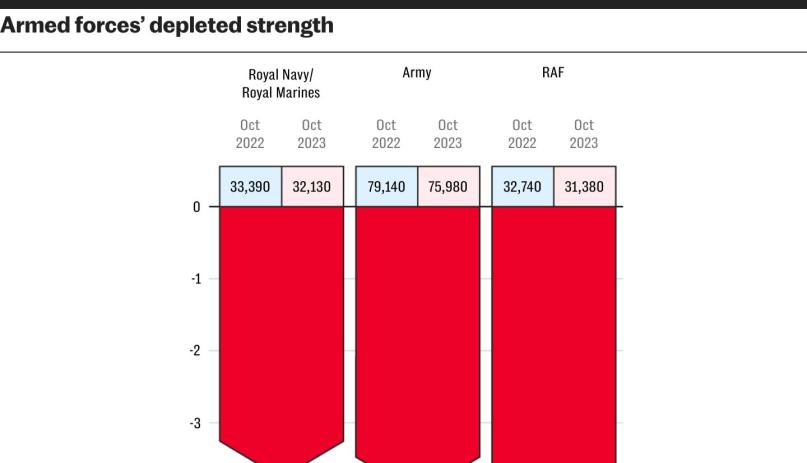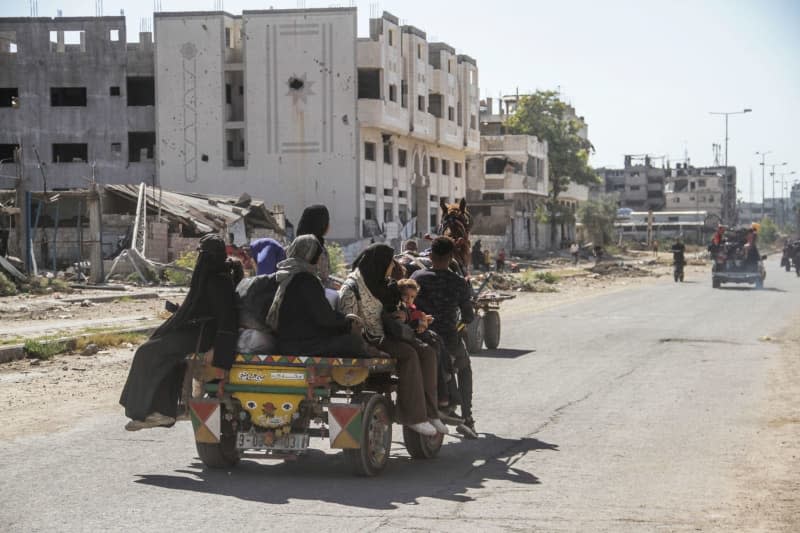Britain is no longer in a position where its Armed Forces can defend the country. That was the frightening assessment of the new Labour Defence Secretary John Healey, who earlier this week said: “The UK, in keeping with many other nations, has essentially become very skilled and ready to conduct military operations.
“What we’ve not been ready to do is to fight. Unless we are ready to fight, we are not in shape to deter.”
He is not alone in thinking this. Many former defence chiefs and even some serving senior commanders have warned that Britain’s fighting forces are now simply too weak to counter state-on-state threats.
Lord Richards, who served as the chief of the defence staff from 2009 to 2013, has an equally bleak assessment of the UK’s fighting ability.
“Never in my long professional life have the Armed Forces been weaker,” Richards told the Telegraph.
“The Army in particular is in the poorest shape it’s ever been. Old equipment, woefully understrength, poorly trained and with a dire shortage of ammunition. Yet the geo-strategic outlook has never been more worrying. It is time the Government spent what is needed to live up to its rhetoric. Or be honest and accept that the UK is just another medium-size European power without dangerous global pretensions.”

Endless defence cuts have left the Armed Forces in a parlous state at the worst possible time. The Royal Navy has ships with engines that can’t function in warm climates, and the carriers the Queen Elizabeth and Prince of Wales – the two most expensive ships built by the Royal Navy – have been forced to undergo embarrassing remedial repair work, such as replacing broken propellers, and have even been made to withdraw from multinational exercises.
Recently, the Army was reported as being so short of ammunition that soldiers had to shout “bang” when firing their rifles.
The Armed Forces’ fighting ability has been further undermined by the number of troops seeking a career change in the hope of a better quality of life. Last year more than 15,000 personnel left, while around 11,000 joined up. Many of those leaving were simply fed up with living in homes infested with vermin, black mould and having to face winters with leaking roofs and no heating.

The last time Britain was in a position where it could possibly deter an invasion by another country was in the 1980s, at the height of the Cold War, when the Armed Forces were composed of more than 300,000 personnel, and dozens of ships, aircraft and battlefield nuclear weapons all designed to prevent the Soviet Red Army sweeping across western Europe.
Back then, the Army in Germany had its own name – the British Army of the Rhine – and troops who served within it even received a campaign medal. Soldiers in some parts of the Army had spent their entire careers serving in Germany. They bought homes in German villages, married German women and enjoyed a comfortable lifestyle very different to that being offered in dreary 1980s Britain.

But that all changed with dramatic speed when the Cold War ended with the collapse of the Soviet Union in 1989. The Tories set about cutting the size and capability of the Armed Forces in the hope of benefiting from a “peace dividend”.
In 1990, the British Armed Forces were in the grip of a defence review called Options for Change – a root-and-branch restructuring of the entire Armed Forces that ended with troop numbers falling by 18 per cent.
In 1989, the British Armed Forces had a peacetime strength of 311,600 troops, and a defence budget of 4.09 per cent of GDP.
The Royal Navy was composed of 65,500 sailors, there were 152,800 soldiers serving in the Army, and the RAF had a force of 93,300 personnel.
Under Options for Change, the British Army taking the brunt of the cuts, troop numbers fell to 120,000 and the size of the Army in Germany was cut by 50 per cent and renamed British Forces Germany.

The RAF also suffered. RAF bases in Germany and the UK were closed down and RAF Germany as a whole was disbanded in 1993. Such was the belief that the future offered little chance of state-on-state conflict that even the Brimstone air-to-air missile system was cancelled, only for it to be reinstated later when geopolitical events began to change.
The Royal Navy saw frigate and destroyer numbers fall from 50 to 40 ships, a move that, at the time, was considered dangerously irresponsible. By contrast today, the Royal Navy has just 12 frigates and eight destroyers.
Options for Change was not the end. Just four years later and faced with an economic downturn, the British government announced that it intended to perform a small review of the state of the Armed Forces.

The 1994 “Front Line First: The Defence Cost Study” paper aimed at applying cuts to the defence budget without affecting the military’s “front line forces”. The plan was to target headquarters, stores, infrastructure, administration and support – effectively the unglamorous and essential backroom staff that keep any organisation functioning efficiently.
The review saw another 11,600 active personnel slashed from the Armed Forces ranks, with the Royal Air Force laying off 7,500 personnel, 2,200 from the Army and 1,900 from the Navy.
A year after New Labour and Tony Blair came to power in 1997, a strategic defence review (SDR) called “Modern Forces for the Modern World” was published, and set in motion a series of seemingly endless cuts that would shape the organisation and capabilities of the British Armed Forces up to the present day.
The aim of the 1998 SDR was to create greater cooperation between the forces and adopt a more expeditionary approach to warfare, in which thousands of troops could be deployed very quickly to trouble spots around the world.
Although there were cuts, they were less severe than the two previous defence reviews. But by 2010, with the arrival of the Conservative-Liberal Democrat coalition, even more cuts were on the table, the deepest since the end of the Cold War. Troops returning from combat in Afghanistan arrived home to find they were being made redundant.
Initially 17,000 personnel were cut from all three Armed Forces, along with aircraft, tanks, heavy artillery and ships. The cuts were largely regarded as going beyond the bare minimum Britain needed to defend itself and were seen as being driven not by strategy but economic priorities.

In 2011, Lord West, a Labour peer and a former head of the Royal Navy, warned that the Tory defence cuts were getting to a point where they should now be considered dangerous. He said in an interview: “I do think we have got to a stage now with cutting of our defence forces that is actually becoming dangerous, and we are at risk of becoming a different nation by default without actually having a proper debate about it, without strategic assessment about it.”
The net effect of years of defence cuts has, according to Rob Johnson – who recently stood down as director of the Ministry of Defence’s office of net assessment and challenge — left the UK military operating with a “bare minimum” that only just allowed it to mount peacekeeping and humanitarian relief operations, civilian evacuation from war zones, and some anti-sabotage activities.
He added: “In any larger-scale operation, we would run out of ammunition rapidly . . . Our defences are too thin, and we are not prepared to fight and win an armed conflict of any scale. The UK has reached a situation where it cannot defend the British homelands properly.”

Johnson said British air defences were “insufficient” to stop long-range missile strikes, the Royal Navy lacked enough ships to patrol the North Atlantic to monitor and deter Russian submarine activity, and the Royal Air Force needed almost twice as many fighter jets as it has now. As for mounting an expeditionary force comparable to those deployed in the Falklands or Iraq wars, British forces “would be under-equipped, leaving troops at risk”, Johnson said.
The solution to these problems of course is simple – spend more money.
Johnson said the next government should aim to boost defence spending to 3 per cent of gross domestic product at “a minimum”. That level, equivalent to almost £80 billion a year, would allow the UK to modernise its nuclear deterrent and have a military “armed and equipped for the conflicts of the 21st century”, he said.
But as the Prussian strategist Carl von Clausewitz noted in 1832: “Everything is very simple in war, but the simplest thing is difficult. These difficulties accumulate and produce a friction which no man can imagine exactly who has not seen war.”
EMEA Tribune is not involved in this news article, it is taken from our partners and or from the News Agencies. Copyright and Credit go to the News Agencies, email news@emeatribune.com Follow our WhatsApp verified Channel




